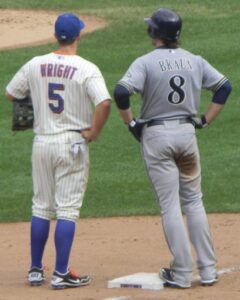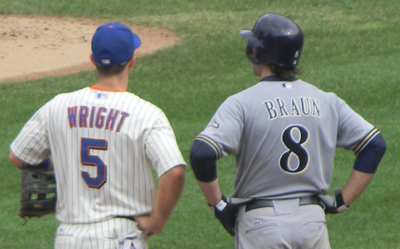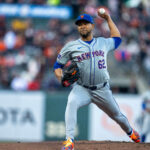Earlier today, my colleague at MMO, Jason Pafundi, wrote an interesting piece on why the Mets should consider trading David Wright. Jason is not the first person on this site or on other sites to explore this topic. The trading of the Mets’ third baseman is a topic that can be argued for days on end, and people on both sides can present valid points to defend their respective arguments.
But I’m not here to discuss why David Wright should or should not be dealt. I’d rather talk about what David Wright should have become. When Citi Field opened its doors for the first time in 2009, David Wright was coming off one of the best three-year stretches in franchise history. His 2006 (.311, 26 HR, 116 RBI, 20 SB), 2007 (.325, 30 HR, 107 RBI, 34 SB) and 2008 (.302, 33 HR, 124 RBI, 15 SB) seasons were eye-popping, to say the least. But since 2009, Wright has been no more than an ordinary player, only occasionally showing flashes of his former self.
The 2009 season marked the first time David Wright spent time on the disabled list, having been felled by Matt Cain’s head-seeking missile in August. However, his bat and approach at the plate seemed to have been on the disabled list long before August. For the season, Wright finished with a career-low 10 HR. His 72 RBI (also a career-low for a full season) might have been a result of the lack of healthy hitters on the team for him to drive in. But it wasn’t all due to the injuries to Reyes, Delgado and Beltran. For the season, Wright hit .206 with a runner on third base and two outs, a situation where the batter can’t depend on a sacrifice fly to drive in the run. Wright also hit .200 with the bases loaded (his OBP in those spots was also .200, meaning he couldn’t even draw a walk with the bases loaded all year) and .200 with runners on second and third.
The most alarming stat concerning the above situations was his propensity to strike out in those scenarios. With a runner on third base and two outs, Wright struck out almost half of the time (16 Ks in 34 at-bats). It got even worse when Wright batted with runners on second and third (8 Ks in 15 at-bats). Although he made contact more often with the bases loaded (6 Ks in 15 at-bats), it’s still a 40% strikeout rate and it gave Wright 30 strikeouts in 64 at-bats in those three big RBI situations. Even with his power outage in 2009, Wright could still have easily driven in 100 runs if his batting average in the three aforementioned situations was more in line with his batting average for the season (Wright hit .307 for the year).
Although Wright’s power returned in 2010 (29 HR, 103 RBI), he did not improve in the key RBI situations mentioned above. Wright batted a combined .250 (10-for-40) in those spots, again striking out almost half the time (19 Ks in 40 at-bats). In addition, Wright batted .260 anytime he came up with at least one runner in scoring position. For the year, Wright batted a career-low .283, while striking out a career-high 161 times.
We don’t really have much of a sample for David Wright in 2011 because he’s spent just as much time off the field than on it, playing in only 71 of the team’s 130 games. But even when he’s played, he hasn’t shown much improvement in the strikeout category (67 Ks in 71 games) and his batting average has gone down to .256.
 That brings us to one of David Wright’s contemporaries, a man who also played some third base early in his career, but has since shifted to the outfield and has shown improvement every season he’s been in the major leagues. That man is Ryan Braun.
That brings us to one of David Wright’s contemporaries, a man who also played some third base early in his career, but has since shifted to the outfield and has shown improvement every season he’s been in the major leagues. That man is Ryan Braun.
After coming out of nowhere to win the National League Rookie of the Year Award in 2007, Braun didn’t suffer a sophomore slump. His batting average dropped to .285 after the .324 mark he registered during his rookie season, but his power production didn’t suffer the same fate, as Braun hit a career-high 37 HR in 2008 while picking up 106 RBI. More importantly, the second-year player didn’t wilt under the pressure of his first playoff race, hitting the decisive two-run homer in the Brewers’ final regular season game, a game in which the Brewers clinched the NL wild card berth over David Wright and the Mets.
Since getting his first taste of playoff experience in 2008, Braun has continued his progression into the upper echelon of National League players. In 2009, he led the Senior Circuit in hits with 203. He also recovered from his only sub-.300 season to hit .320 while not skimping on the power (32 HR, 114 RBI). Of course, Braun didn’t just stop there, adding another dimension to his offensive game by stealing 20 bases. It was more of the same in 2010 for Braun, as the Brewers’ leftfielder hit .304 with 45 doubles (which is more than any Met has ever registered in a single season), 25 HR and 103 RBI. His contact rate also got better, as he struck out 105 times in 2010 after whiffing 121 times in 2009 and a career-high 129 times in 2008.
In 2011, Braun has become the leading candidate to win the National League MVP Award. His .333 batting average is second to the Mets’ Jose Reyes and his contact rate has improved dramatically, striking out only 75 times in 507 plate appearances. Braun is also leading the league in runs scored (91), slugging percentage (.592) and OPS (.996), and is currently in the league’s top ten in a plethora of categories such as hits (160), extra-base hits (62), on-base percentage (.404), total bases (265), doubles (33), home runs (25), RBIs (86) and stolen bases (30). And of course, he’s helping the Brewers open up a commanding lead in the NL Central.
So how does Ryan Braun do in key RBI spots, especially since I made such a big deal out of how David Wright has performed poorly in those situations? Actually, Braun’s career numbers are quite good whenever an RBI is there for the taking. In five years in the major leagues, Braun has hit .265 with a runner on third base and two outs, striking out 25 times in 117 at-bats. His numbers are even better in the other two scenarios. With runners on second and third, Braun is a .286 career hitter with 11 strikeouts in 49 at-bats. Finally, with the bases loaded, Braun’s eyes light up. In 63 career at-bats with the bags full, Braun is hitting .317 and has only struck out 10 times. Overall, the Hebrew Hammer is hitting .306 over his major league career with runners in scoring position, which is right in line with his career numbers.
David Wright has been one of the best players the Mets have had in recent years, but he could have been so much better. If he is not traded at some point, he could still turn his career around, but nothing in recent years has suggested that a renaissance is about to occur. Just the fact that his name is being mentioned around the blogosphere in potential trades suggest that the fans don’t think of him as “the savior” he was supposed to be. He may not be that savior of the franchise, but at the very least, he could have been like Ryan Braun, a player who has continued to improve every aspect of his game from season to season.
It’s too bad David Wright hasn’t been able to continue his forward progress past the 2008 season. Until he does, the word “trade” will never be too far behind in discussions of the Mets’ third baseman.















